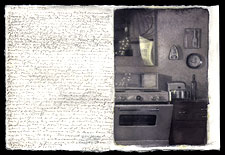
“Kitchen,” 4×6″, watercolor, gouache, graphite and conte crayon on Fabriano paper.
|
Artists who use their exotic travels as inspiration are sometimes cautioned that they might make more authentic work by painting or drawing the things they know best.
Charles Ritchie has taken this warning to heart.
For more than 20 years, he has described in pen-and-ink, graphite and print media the images he sees every day and every night through the windows of his suburban home near Washington, D.C. His exhibit at Warren Wilson College’s Holden Gallery confirms that paying attention matters. We see no splashy colors, no confrontational subject matter and no self-important trompe l’oeil virtuosity: just honest impressions derived from intense observation.
The works on the wall are accompanied by sketch books, some pocket-sized, dating back to the early 1980s. These small volumes are treasures not only because of the images inside them but for the text they contain, giving a true record of the artist’s process: It would be hard to imagine a more appropriate show for a college gallery. Ritchie, in the handsome catalogue accompanying the exhibit, generously shares all the details of his sometimes simple, but more frequently complex, methods.
Refreshingly, he talks as much about what didn’t work as about what did.
Viewers with short attention spans might walk into the gallery and be unimpressed by the display: The works are overwhelmingly small and dark. But those who have the patience to look at the pieces with care will be rewarded with a sense of mystery and wonder.
In 1983, Ritchie observed soft light flooding the edges of a rocker — and thus his journey of exploration began. He quickly made a tiny watercolor image in a sketch book. This was followed by an intricately detailed drawing of the same chair with the exterior light filtering through the branches of a hemlock. Thirteen years later, he created a mezzotint from the original sketch, altering the paper shape and the amount of light. This final image has a haunting familiarity. In the catalogue, the artist says the image brought to his mind childhood songs sung by his mother and grandmother, creaking made by the floor underneath their rockers, and the distant sound of a train coming down from the mountains in his native Kentucky.
A few years after the rocking-chair sketch, Ritchie interrupted his household’s domestic routine when he saw fabric draped over an armchair with an intense light from the window playing over the folds. For weeks the upholstery project was in limbo while he made drawing after drawing of the chair and the light. An exhibited drawing of this chair is done in graphite, pen-and-ink and watercolor. While the drawing is vertical, the mezzotint of the same chair, done much later (in 1997), is more horizontal and much darker. An outsized feeling of anticipation stirs in this small work — something big is about to happen in that dark space to the right of the chair.
As time passes, the works become more complex. There are evening landscapes seen from inside the house, with objects in the room reflected in the panes of the windows — seemingly endless layers of reflections.
These dated pieces show that the artist returns again and again to an image that resonates. His studies for “Night with Terraces” are dated 1993 and 1994, while other pieces based on the same images were executed much later — one was begun in 1995 and completed in ’97, while a monotype with the same title was finished the following year.
Even so, the show’s most impressive feature is a journal entry from 1982, wherein Ritchie depicts a series of lights reflected on a Massachusetts lake. His powers of observation are just as extraordinary in this simple watercolor as in the most technically difficult of the other remarkable works.
Here is an artist who, in his day job as a curator at Washington’s National Gallery, is keenly aware of the chaos of the postmodern art world — but who chooses to ignore the latest thing in order to follow, with conviction and a quiet intensity, his own interests, close to home.
[Connie Bostic is an Asheville-based painter and writer.]
Charles Ritchie: Works on Paper will show at Holden Gallery at Warren Wilson College through Friday, Nov. 3, when the artist will give a talk at a closing reception. Call 771-2000, ext. 3034.



Before you comment
The comments section is here to provide a platform for civil dialogue on the issues we face together as a local community. Xpress is committed to offering this platform for all voices, but when the tone of the discussion gets nasty or strays off topic, we believe many people choose not to participate. Xpress editors are determined to moderate comments to ensure a constructive interchange is maintained. All comments judged not to be in keeping with the spirit of civil discourse will be removed and repeat violators will be banned. See here for our terms of service. Thank you for being part of this effort to promote respectful discussion.